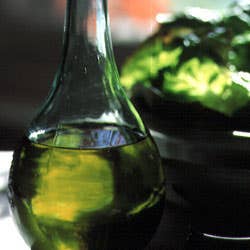
Earliest food memory: standing on a chair, leaning over a kitchen stove, watching shimmering islands of Italian olive oil form atop the world's best tomato sauce, as the whole pot is stirred lovingly by the best chef I've ever known—my mother, of course. Since then, I've associated that thick, sweet, pungent smell and that round, earthy taste with a feeling of being fed, of being nurtured on the deepest level.
After that, those Brand X vegetable oils—devoid of smell, taste, texture, even color—never satisfied at all. They left me feeling unloved and uninvolved, still hungry for flavor. Now, happily, delis and pasta shops and epicurean emporiums all feature shelves practically glutted with the highest quality olive oils from around the world. And right there next to the legendary Tenuta del Numerouno from the Tuscany region of Italy and the Nuñez de Prado from the prestigious olive-producing Baena area of southwest Spain, is a collection of olive oils from a place previously overlooked as a world-class producer: California.
Here, olive oil is an old condiment with new cachet, thanks to a boutique industry in which fine bottles of extra-virgin oil are made from olives grown, pressed, and bottled locally.
In truth, this can't be called a trend as much as a renaissance. Olives and their oil were products of California long before it was even a state. Franciscan missionaries, migrating north from Mexico in the late 1700s, planted Spanish olives with as much fervor as they converted the natives—perhaps thinking that the biblical olive would expedite enlightenment. Today, wherever missions are found up and down the California coast, there are olive orchards, too.
The earliest chronicle of olive oil production in America dates from 1803, when a missionary noted that excellent oil was being pressed at Mission San Diego de Alcala in what is now Southern California. With a slow, steady increase in demand for oil, the number of olive trees in the state jumped from 503 in 1855 to 5,600 in 1876 to 540,000 by 1901. New trees were propagated using cuttings from the original mission orchards, and Italian and other European varieties were imported by local entrepreneurs.
Then, in the early 1900s, the bottom fell out. California growers had learned to produce oil that could sometimes rival the quality of the European varieties, but they couldn't do it at competitive prices. At the same time, inexpensive vegetable oils began to gain in popularity. The olive industry shifted from making oil to canning olives after perfecting a curing and brining method that all but eliminated the bitter taste of the fruit (along with most of its flavor).
California olive oil production revived during both world wars when imported oils became unavailable, but then petered out again in the 1950s—though one producer in particular, Nick Sciabica & Sons, in the Central Valley town of Modesto, has stayed in business since 1936.
Of the numerous varieties of olives grown in California, the three most popular are still Spanish: manzanillo, which produces oil with a sweet, intense, oily flavor; sevillano, whose oil is strong, with a hint of artichoke; and mission, which makes a mild, fruity oil with a slightly peppery aftertaste. Two French olives—picholine and lucques—produce alternately sweet, mild oils or peppery, tart ones. And then there are four Italian varieties—pendolino, frantoio, leccino, and maurino—being reintroduced in California. The hope is that their oils will rival the Tuscan oils in character, with robust fruitiness and a touch of pepper at the end.
Yet, after all is said and done, there's no great secret to making good oil. "You step on an olive, you get olive oil," goes an old Italian saying. But there's another old Italian saying that speaks to the ambitions of the new Californian pioneers: "You plant grapes for your children. But for your children's children, you plant olives."
Keep Reading
Continue to Next Story










